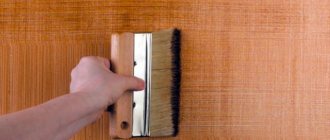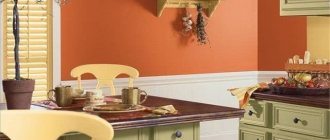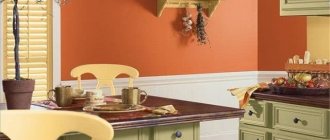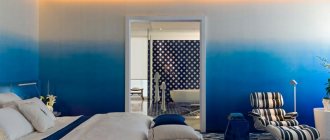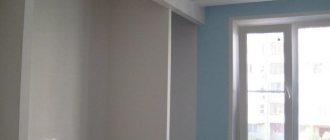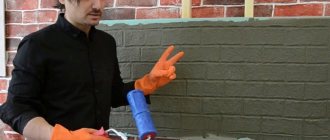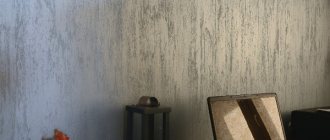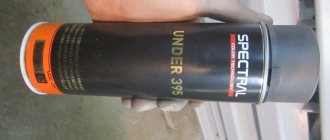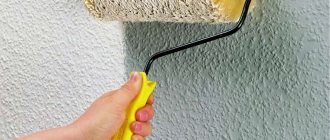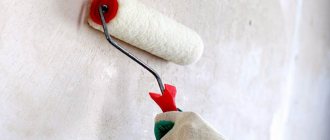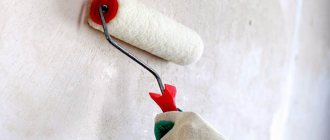What is decorative wall paint and methods of applying it
Decorative painting of walls allows you to obtain a variety of original effects from paint and varnish materials. Special paints are used for this purpose. For example, you can imitate stone, silk, wood and much more. Such a coating will look beautiful and unusual.
Obtaining the effect is possible thanks to the constituent components of the paints. To change the pattern on the wall after drying, special plastic elements are used in the composition.
Decorative painting of walls allows you to obtain a variety of original effects from paint and varnish materials.
How to apply decorative paint for walls: video review of technology and recommendations
To work with decorative paint you will need a certain set of tools. Before starting work, you should make sure you have:
- containers of a suitable size (basin or bucket);
- construction mixer (you can use a drill with a special attachment);
- a set of paint brushes of different sizes and with different bristles;
- foam rubber or natural sponge;
- spray bottle;
Depending on the desired result, several types of tools and available materials can be used when painting.
- set of spatulas;
- paint rollers;
- trowel;
- rules (length 2-3 m);
- graters;
- cellophane film and protective equipment (gloves, glasses, long sleeves, bandanas or caps).
Helpful advice! To get the original color of the walls, you can use a pneumatic sprayer. Having filled the tool with paint of the required color, you need to set the pressure at 5 atmospheres and install a nozzle with a diameter of 0.3-0.5 cm on the device.
Advantages of decorative paints
Decorative painting of walls has become increasingly popular lately. The reason is the positive aspects that these paints have. These include the following:
- The service life of the resulting coating is twice as long as that of gluing wallpaper or using plasters;
- The decor helps hide the joint areas;
- A variety of effects that make it possible to implement various ideas;
- Moisture resistant property;
- The ability to update a layer without first removing the previous one;
- The water-based type is safe for human health;
- Suitable for working with any material.
The service life of the resulting coating is twice as long as that of gluing wallpaper or using plasters.
Textured painting of walls: step-by-step instructions
Textured painting of walls is a type of decorative finishing that allows you to create relief patterns on the surface of structures due to the density of the material used. Using textured paint you can not only decorate walls, but also mask their minor defects. The color of the material can be easily changed by adding acrylic pigments.
Advantages and disadvantages of textured coatings
The main difference between textured paint and its “smooth” counterparts is the aesthetic component, which helps give the walls a beautiful and surprising effect. Coatings created on the basis of decorative paints have a lot of advantages, which explains their wide popularity:
- The average service life of textured wall coverings is 10 years, while wallpaper can last no more than 5 years. In addition, faded or worn canvases will have to be removed and replaced with new ones, and the textured coating can simply be refreshed with a new layer of paint. This greatly simplifies repairs and saves time.
Decorative textured coatings do not fade from exposure to sunlight, have sufficient mechanical strength and are not afraid of mold.
The surface of the walls, painted with this material, has a monolithic appearance, creating a harmonious single picture.
The textured coating is easy to wash, and it is much more difficult to put a stain on its surface than on paper wall wallpaper, which often gets dirty quickly in the corners and around switches.
The choice of design effects and various shades when painting walls with textured water-based paint is so huge that it will satisfy any demanding designer and will amaze the homeowner who is inexperienced in this matter. When applying layers of textured paint using spatulas and special rollers, you can feel like a skilled craftsman, experimenting with texture and colors. Due to their diversity, decorative coatings fit perfectly into almost any interior.
Textured water-dispersion paints, being completely safe for health, will perfectly fulfill their purpose in children's rooms. The coatings do not contain carcinogens and do not cause allergy attacks.
The materials are universal; they can be used in the design of kitchens, respectable living rooms and bright rooms for children with equal success. The moisture resistance of textured paints allows them to be used for facade work and bathroom walls.
Antistatic decorative coating does not absorb dust.
Each textured coating applied to the wall is unique. This differs from wallpaper, the mass production of which often makes the walls of different apartments look the same. When working with decorative paint, you always get something original; the use of special technologies makes it possible to achieve completely different effects using the same bucket of paint.
The textured coating looks natural and rich on the wall surface, which transforms an ordinary apartment into a beautiful, cozy home.
- Despite the sufficient thickness, the coating has good permeability and does not create obstacles to air circulation in the premises.
The disadvantages of painting walls with textured paint include the need for preliminary preparation of the base, although this coating is perfectly applied to wooden panels, finishing putty, plywood, gypsum board, chipboard, metal and glass. The surface of the walls must be smooth before painting, but the paint can fill small cracks in it itself.
Another disadvantage is the increased consumption of material, which is 1 kg/m2 of walls; this circumstance significantly affects the cost of the coating, causing it to rise in price.
Decorative effects of textured wall paints
Textured paints that can transform rooms thanks to their special design effects are very popular today:
Mother-of-pearl effect
. Such colors make the room brighter, which is especially important in cloudy weather in the autumn-winter period. At different angles and types of lighting, the mother-of-pearl coating has the ability to change color, for which the material received the name “chameleon paint”. The walls painted with it have the appearance of stretched silk fabric.
Velvet or velor effect
. This paint contains colored solid particles. A wall treated with this material has the appearance of velor fabric - just as textured, soft and deep.
Granite paint
. Contrary to its name, it does not have granite chips. The impression of its texture is formed by acrylic bubbles of paints of different shades, which are broken when the material is applied to the wall using a spray gun.
. They contain shell fragments, mineral particles, fine sand and other additives. Each type of such ready-to-use paint gives its own special effect: shiny and embossed surface, coral wall, seascape, etc.
Ready-made textured paints do not require the addition of pigments or the use of special technologies for applying them to walls. You just need to carefully prepare the surface and decide on the tool that will be needed to work with the material.
Preparing walls for textured painting
Work on painting walls should begin by protecting the floor covering and ceiling with film from unwanted contact with dust, debris and splashes of material in the process of preparing and decorating the surfaces. The film can be secured with masking tape.
Before textured painting of walls, it is necessary to remove old finishing material, stains of rust, mold and grease from them using all mechanical devices and chemical means suitable for this purpose.
After this, it is necessary to seal the existing cracks in the walls and level the surfaces to be painted with plaster or putty.
After the walls have dried, they need to be treated with a penetrating primer to create adhesion of the materials to the base and reduce paint consumption for finishing. The primer should be applied with a paint roller.
Five hours after priming, you can begin working with textured paint. It must be stirred well and the pigment of the desired color must be added. To facilitate the painting process, the material can be diluted a little with water, but its volume should not exceed 1% of the weight of the paint.
Technology of applying textured paint to walls
The job of painting walls is similar to the putty process. It is performed in various ways. The common point for them is that the paint is applied to the surface of the walls with a wide spatula, with which an area of no more than 2 m2 is treated. The corners of the walls are painted using a narrow spatula.
A small amount of the textured mixture is taken on a spatula and then applied to the surface of the wall. Then, with the help of various devices, it is given the desired texture. After a couple of hours, the paint will begin to stick to the wall and after two days it will dry completely. Only after this process is completed can acrylic, varnish or wax be applied to the surface.
When painting textured walls, you can apply the pattern manually or use a stencil for this purpose. Applying a relief to a plain coating is done by rolling it with a cloth or tapping it with a brush with stiff bristles.
Imagination can suggest any ideas for applying patterns. These can be waves, tree branches or various shapes. To give the painted surface a relief, you can use many available materials.
Ways to create a textured pattern on the walls
Applying a textured pattern to the surface of a painted wall can be a difficult task for an inexperienced person. Therefore, it is advisable to first practice on a certain section of a plane. This will help you acquire the skill and avoid the cost of redoing finished work.
When painting walls with textured paint with your own hands, you can use various methods to create relief:
- Using a foam roller
. White textured paint should be applied to the wall and leveled using a wide spatula. Then the surface should be rolled with a roller, giving it the desired structure. After a day, you need to apply pale blue paint to the texture, and carefully remove its remnants with a foam sponge. For the final finishing, the dry surface of the wall must be treated with a grater, the resulting dust must be removed with a dry brush and the finishing layer of pearlescent enamel must be applied to the coating using a fine-pile roller.
Using a trowel
. In this case, it is necessary to apply two layers of light brown textured paint to the wall, the first of which is applied with a spatula, and the second with a trowel. A day after the surface has dried, it should be painted with white matte enamel using a fur roller.
. With this method, the material must be applied to the wall using a wide spatula, and then using a rubber textured roller to paint the walls, create the desired pattern.
In addition to the above tools, improvised means are often used to create a relief surface on a layer of paint. For example, a thick rope wrapping around a roller. When rolling a wall with this device from top to bottom, a pattern reminiscent of bamboo stems is created.
If you use a wad of newspaper wrapped in plastic or hitting a freshly painted surface with a wet rag, you can give it an original and interesting design.
Two-tone textured wall painting
Using textured paint you can create two-color designs. This type of wall decoration has become very popular. For example, you can make various strokes on fresh paint with a sharp object, and then immediately, before it dries, use a mixture of a different color using a stencil to create a new design on the wall. The resulting result will decorate its appearance.
Clear outlines of geometric patterns will look good on the wall. In order to make textured painting of walls with such a pattern with your own hands, you need to apply masking tape to fresh solution to get an imprint on it. Then you need to apply paint of a different color to the tape.
The most effective and simplest method of creating a two-color coating is to scratch the still wet surface with stiff bristles or the teeth of a comb. The best effect is achieved with a chaotic arrangement of scratches.
How to paint walls with textured paint - watch the video:
Types of decorative paints
The construction market offers a huge number of paints for wall decoration, which differ in their properties. To better understand which decorative paint option is suitable, you should study the features of popular products. Each will be discussed in more detail below.
The construction market offers a huge number of paints for wall decoration, which differ in their properties.
Acrylic
This type is one of the most popular. It does not emit an unpleasant odor and has good moisture resistance. Suitable for all types of substrates. There is a large assortment of paint colors, and there are also different effects - glossy, pearlescent, matte and others. The drying process does not take much time.
Suitable for all types of substrates.
Latex
The type is distinguished by its high level of resistance to moisture; the coating can decorate small surface defects. This is a high-quality and expensive product that will last for many years. However, color fading in the sun is noted.
The type is distinguished by its high level of resistance to moisture; the coating can decorate small surface defects.
Water-based
One of the budget options for decorating walls with paint. But water-based paints cannot withstand exposure to moisture. Apply it to a plastered surface, putty, or wallpaper for painting. The composition is colorless; dyes are used to add color.
One of the budget options for decorating walls with paint.
Alkyd, oil
These types of paints stand out for their rich, bright color, form a durable layer on the base, and last for many years. The disadvantages are the strong smell of the product, a small number of shades, high cost and wasteful consumption.
These types of paints stand out for their rich, bright color, form a durable layer on the base, and last for many years.
Silicone
This is a universal type and has a high degree of hiding power. A two-layer coating can cover small surface imperfections. Painting results in the formation of a smooth film that protects the wall from abrasion and creates a moisture-resistant effect.
This is a universal type and has a high degree of hiding power. A two-layer coating can cover small surface imperfections.
Silicate compounds
The composition uses “liquid glass”, it helps to obtain a highly durable coating. They are distinguished by a high degree of vapor permeability. Withstands exposure to high humidity due to the presence of antiseptic components.
The composition uses “liquid glass”, it helps to obtain a highly durable coating.
Decorative paint for walls with the effect of silk and silk threads
Many manufacturers have wall paint that looks like silk. If there are at least several decorative or interior paints, then one of them is silk. The look is very sophisticated and delicate. Suitable for living rooms, bedrooms. In terms of performance (acrylic can be washed with a brush), it can also be used in the hallway, but if you are satisfied with such a “refined” look of your hallway.
When choosing, pay attention to the base. Security is important for housing. The best option is silk-effect paint based on aqueous acrylic dispersion. It is relatively inexpensive (when compared with silicone, for example), washable, does not fade and can be painted in all colors. Many decorative paints are made on this basis. To obtain paint with a silk effect, a special type of mother-of-pearl and pigment are added to it.
This is what interior silk paint looks like on a wall
Paint consumption is average, you will have to paint in at least two layers. This is for low absorbency or pre-priming. The absorbent surface will require three coats exactly. And paint is not cheap, so it’s better to prime it. If the paint is based on acrylic dispersion, then we use acrylic primer. But it's better from the same company as the paint. There will be no problems with product compatibility.
The disadvantage is that the surface to be painted must be flat. Almost perfectly flat. The second point is that if you want to get “exclusive”, you need to master the application technique. You can, of course, just roll it out with a roller. It will work out well too. But it could be more interesting.
You can wash it with detergent (not abrasive), a rag or a brush. This cleaning does not affect the appearance. In the sense that it is not getting worse. Where the walls are frequently touched, “glossy” areas may remain. If you want this type of finish in your hallway, consider a varnish finish. But this type of paint “breathes”, so if you varnish it, you will lose this effect.
Each company that produces silk-effect decorative paint has a slightly different appearance. Some have multiple options. And not colors, but textures
If you think that silk effect paint looks the same from all manufacturers, you are mistaken. They use different additives, resulting in slightly different surfaces. This type of decorative paint is popular, so some have several paints that give different textures. There are also different application techniques. With their help, you can get different types of surfaces: classic, wet and crushed silk.
Is it possible to create a decorative effect using regular wall paint or why pay more?
You can use several simple techniques to get an unusual effect without special paints. An example is applying one layer of water-based paint, onto which another color will be applied with a sponge. The result is a “crumpled paper” effect.
To obtain the marble effect, the surface is painted sequentially in different colors, then treated with a stiff brush, and a special wax should be applied. Fabrics, yarn and other available materials are also used for various options.
You can use several simple techniques to get an unusual effect without special paints.
Useful tips
Before applying water-based paint, you must mix it thoroughly, and then repeat these steps again after you have selected and added the filler. It is best to use a drill with a mixer attachment. You need to stir for 5 to 10 minutes.
The paint should be applied in a thick layer. It is better to paint over the entire area at once to avoid the visibility of joints. Prepare the tool you will be working with in advance. One important factor is the choice of paint. Pay attention to the brand of the product. It is better to choose well-known and high-quality brands, such as VGT, Magic and many others.
If the paint contains colored solid particles, the surface will have a velor or velvet effect. When adding filler, which includes elements such as quartz sand or shells, the pattern will look like a sandy surface (Atacama).
Matte options are good because light is scattered when it hits the walls, thereby hiding surface imperfections. The addition of special pigment fillers to the paint gives the composition a unique pearl shine.
We recommend: How to get rid of oil paint stains on clothes?
Tools needed to create an unusual decorative effect when painting a wall
To treat the wall surface with decorative products, you should purchase tools for the job in advance. Without them, it will not be possible to get the desired result. For repair you will need:
- Paint roller;
- A variety of spatulas: plastic, metal, rubber, serrated;
- Sponges;
- Hard brushes to remove build-up;
- Sandpaper;
- Stencils.
To treat the wall surface with decorative products, you should purchase tools for the job in advance.
Preparing walls for work
The preparatory stage is an important stage of the entire surface finishing. Experts recommend doing the following:
- Clean the surface of old finish.
- Primer is applied.
- Inspect the walls for evenness.
- Defects are covered with putty solution.
- Sand these areas.
- The primer solution is applied again.
The preparatory stage is an important stage of the entire surface finishing.
What effects can be created on the wall using ready-made decorative paint?
The number of types of coatings obtained using such compositions is large. You can note the receipt of a pearlescent glow on the walls, which will lead to filling the room with light. The silk covering looks very beautiful and presentable. There are similar effects - velvet and velor. The effect of stone, granite, marble are also popular.
This is a cheaper option than using real materials.
The silk covering looks very beautiful and presentable.
Features of decorative painting for walls
What is the difference between regular wall painting and decorative painting? The differences are quite noticeable. Regular painting will simply transform your wall into a different color. And if we talk about decorative painting, then a unique pattern, structure and shape are created on the surface, along with coloring. Let's look at the benefits of decorative painting for walls.
Advantages of paint:
- Long service life. The minimum is approximately 10 years. But please note that during this period the paint will not fade or deteriorate. You won't have to repaint anything. As for expensive decorative wall paints from well-known manufacturers, they will last you 25 years!
- Paint resistance to various influences. The coating protects the wall and is not easily damaged. In addition, the composition will not fade in the sun and will not be erased. And you can completely forget about the appearance of mold, since the composition contains special protective agents.
- Solidity of the coating. No joints are formed, the surface looks beautiful and creates a wonderful atmosphere in the room.
- Easy to use. You can wash the wall without any problems, removing dirt and dust. In addition, stains will appear much less frequently on such a surface.
- Composition safety. Properly selected paint will not cause harm to residents, as it will not emit harmful substances. Moreover, the composition does not burn, which makes your stay in the room even safer.
- The antistatic nature of the paint ensures that the walls will not collect dust.
- Attractive and original appearance.
As you can see, there are a lot of advantages of the material. But decorative paint also has its drawbacks. There are very few of them, but they are there:
- You will need to carefully prepare the walls for painting yourself. Next we will take a closer look at what is included in such preparation;
- When compared with regular paint, the price for decorative compositions is slightly higher. Sometimes you will see a price tag of about 1000 rubles per 1 kg of material. Although there are cheap options, 300–400 rubles each, they are not of such quality.
If we understand the description of decorative paint, let's look at the technology of work to change your house or apartment beyond recognition.
Application methods
Special products are expensive, so craftsmen resort to a variety of methods to create the desired effect using conventional paintwork materials. Decorative painting of walls with your own hands, unusual application methods will be described below.
Special products are expensive, so craftsmen resort to a variety of methods to create the desired effect using conventional paintwork materials.
Textured coloring
To obtain a voluminous coating, you can use a sponge, which results in a rocky surface. Textured paints contain quartz sand, which gives roughness. A brush with long bristles will help to form different voluminous lines, while a brush with short bristles can be used to create drawings.
A brush with long bristles will help create different voluminous lines.
Frottage
For this technique, take a plastic bag or paper. With the help of which a pattern reminiscent of compressed paper is created on the painted surface.
For this technique, take a plastic bag or paper.
Sponging
For sponging, you need to use a sponge with large pores to apply paint on the wall in a chaotic manner; the colors may vary. The result is a bright coating.
Sponging requires using a sponge with large pores to apply paint on the wall in a chaotic manner.
Using a fabric roller
The step-by-step process for obtaining such a coating involves painting the surface with one layer of paint. After it dries, choose a different shade, darker than the main one. It is applied with a roller covered with fabric. Painting is carried out from below, movements are made in different directions.
Painting is carried out from below, movements are made in different directions.
Ornament
To create an ornament, paint the wall with two colors of paint. The second color is applied with special textured rollers; the shape is selected based on the design. You can also wrap the roller with yarn or fabric.
To create an ornament, paint the wall with two colors of paint.
Color combination
For this technology, several colors of dye are prepared. They are selected to match the overall interior. Selected colors are applied one by one to achieve an unusual design.
Selected colors are applied one by one to achieve an unusual design.
Gradient and ombre
On the surface, the color transitions into darker or lighter shades. To carry out coloring, the paint is diluted with the pigment in stages, the composition is applied one by one, with one roller, so that a gradual transition occurs.
On the surface, the color transitions into darker or lighter shades.
Borders
You can remove the boundaries of color transitions using a sponge, which will gently smear the product on the surface, then the painting will look natural.
You can remove the borders of color transitions using a sponge, which will gently blur the product on the surface.
Stippling
Get an aging effect. The wall is painted in one layer, colored glaze of a suitable shade is applied on top, it is smoothed with a brush, then the uncured areas are treated with it. Use a round brush to press on the walls to obtain the required coverage.
Get an aging effect.
Skin effect
Latex paint is applied, glaze mixed with latex paint is applied to the first dried layer, the shade should be darker. The solution is smeared onto a section of the wall, then pressed on it with a suede brush.
Latex paint is used.
Venetian plaster effect
Paint is poured into the container for the roller, into which pigment is added, more in one half to get a darker color, less in the other. The colors are applied to the wall one by one. Then the roller is moved randomly.
The colors are applied to the wall one by one.
Horizontal division
The room is zoned, a dark color is applied below, a light color is applied above. Only small stripes can be applied around the perimeter of the room.
A dark color is applied below, a light color on top.
Horizontal and vertical stripes
Following the example of the previous method. Make stripes of different colors either vertically or horizontally. The result is a modern design. The main color of the wall should be lighter.
The main color of the wall should be lighter.
Stencils
Using stencils is easy. With their help you can create various designs on the wall. The color of the picture can be contrasting, or just a different shade of the main one.
With their help you can create various designs on the wall.
Divorces
Pearlescent paint is usually chosen for stains so that they create an unusual glow.
Pearlescent paint is usually chosen for stains so that they create an unusual glow.
Contrasting paint using masking tape
Masking tape will help differentiate the application of contrasting colors. It is glued along the perimeter where the first color should be applied and then in order. After the composition has dried, the tape is removed.
Masking tape will help differentiate the application of contrasting colors.
Decorative paint for walls as a finishing material
Decorative or texture paint for walls can be classified as one of the types of decorative finishing, thanks to which you can create beautiful relief patterns on the surfaces being treated. This was made possible due to the special composition and density of the material. The coloring composition can have a creamy consistency, or it can be a thick viscous mass made using acrylic components.
Modern interior designers recommend highlighting an accent wall with textured paint.
To some extent, decorative paint can replace paint and varnish coating and finishing plaster. There is no need to carefully level and plaster the surface. It is enough to putty the walls for painting in areas where there are large cracks and deep holes, and then apply a coating in the form of acrylic impregnation.
Note! Painting, which gives surfaces a textured effect, can be used not only as a decorative finish. This material perfectly hides small defects on the walls that ordinary paint or wallpaper cannot disguise.
Types of decorative paints for walls in apartments
Structural dyes are available for sale in two versions:
- Liquid - the compositions are completely ready for use. They already have the required shade, so there is no need to use color.
- Dry - the second name of these compositions sounds like decorative plaster. This type of dye is diluted with water, where dye is added to give the desired shade.
Decorative paint can give a wall an interesting textured effect.
Acrylic latex used in the production of decorative paints undergoes polymerization during evaporation and absorption of water. Due to this, the drying time of the dye is only 1-2 hours. As a result of using the material in its pure form, a layer of finishing 0.2-2 mm thick is formed on the surface. If you add additional components to the dye, such as sawdust, sand and other materials, you can increase the layer thickness to 0.7-1 cm.
When using additional components, the composition can be used as plaster to smooth out small damage on walls (up to 2 mm deep). Due to the fact that the aqueous solution of acrylic penetrates deep into the surface being treated, which can be made of concrete, brick and covered with plaster, the adhesive properties of such paint can be compared with the capabilities of most cement mortars.
After the polymerization process is completely completed, the surface of the acrylic material acquires waterproof properties. For this reason, many textured dyes are suitable not only for interior but also for exterior decoration.
One of the most popular types of decorative wall paint is sand effect.
Note! Textured decorative paint for interior wall decoration can be safely used to design a bathroom or kitchen, where the air humidity level is high. After the composition has dried, the surfaces will be reliably protected from mold and moisture.
Types of fillers in structural paint for walls
Density and relief are ensured by the particles that are included in the dye. Textured finishing materials are also classified according to the type of fillers, which can be:
- gas silicate in crushed form;
- marble or granite chips;
- metal particles with a reflective surface;
- quartz sand;
- fibers of natural or synthetic origin;
- wood sawdust.
The composition may also contain modified starch as a thickener and special pigments, thanks to which you can obtain paint for walls with the effect of silk or pearlescent coating. Most often, such particles are in the form of drops or flakes.
Some types of paints have additions - sparkles, flakes, pile and other materials, which in the end will be beautifully distributed on the wall
The relief of the dye and the depth of its structure depend on the size of the filler particles:
- Fine-grained dyes are created on the basis of filler particles with a diameter not exceeding 0.5 mm.
- Medium-grained compositions - include particles 0.5-1 mm in size.
- Coarse-grained dyes - the composition contains fractions with a diameter of 1-2 mm.
Before purchasing graphite wall paint or another dye option, you should check the manufacturer's recommendations for use. Plaster, wood, brick or stone masonry, and concrete surface can be used as a basis for applying the dye.
Disadvantages of interior paints for walls and ceilings
The main distinguishing feature of decorative dyes from compositions that form a smooth surface is their decorative effect. With the help of structural paints you can achieve amazing effects. There are options on sale that imitate various types of natural surfaces and materials:
- sand;
- wood;
- stone.
Textured paint can add depth and completeness to a room.
Note! Material consumption is about 1 kg/m². Before making a purchase, it is worth calculating the budget in advance, since the total cost of finishing can be very high, because the price of decorative paint for walls, especially with unusual effects, is much higher than that of wallpaper or standard dyes.
Despite the fact that painting can be done over finishing putty, panels made of wood, chipboard, glass, plywood, metal and plasterboard (plasterboard sheets), the base still requires preparation. A high-quality result is only possible if the base surface is smooth and clean. In addition, certain skills may be required to create a creative design. This is where the finishing flaws end.
Advantages of interior paints for walls and ceilings
Advantages of finishing in the form of decorative paint:
- long service life - the average is 10 years, while high-quality wallpaper can last about 5 years;
- the ability to update the coating by applying a new layer of paint without the need for prior removal;
- environmental friendliness and safety;
To create special effects when using texture paint, you must use additional tools - a roller, sponge or a special spatula
- resistance to mechanical stress and exposure to sunlight. The surface does not provoke the development of mold;
- the possibility of creating a monolithic coating;
- Easy care system due to washable surface. At the same time, the paint repels dirt well. This advantage is especially relevant for corners and areas around switches;
- the choice of design solutions, shades and textures will not force the buyer to think about how to get an unusual effect. Even the most sophisticated will find suitable options for their home;
- the material gives complete freedom in terms of experiments. You can choose different shades or reliefs. Textured paint is applied in layers using special rollers or spatulas. The choice of tool depends on the effect you want to achieve;
- the versatility of the paint allows it to be used for decorating the walls of the living room, kitchen, children's rooms, and bathrooms;
- rich appearance;
- unique textured pattern;
- the decorative coating has antistatic properties, due to which dust is repelled from the surface;
- good vapor permeability of the coating, which does not create obstacles to the movement of air masses in the room.
Some types of texture paints require several layers of different shades and structures.
Cost of decorative paint from different manufacturers
To understand in advance how much paint for a particular company will cost, you need to calculate the area of the room. Professionals say that decorative paints are economical to use. Typically, 2.5 liters of paint are enough to paint 40 square meters. Consumption can always be seen on the packaging.
Of course, the price will depend on the class of the company. Cheaper products from domestic manufacturers, for example Tex. Among the foreign ones we can highlight funds from Tikkurila, San Marco and others.
To understand in advance how much paint for a particular company will cost, you need to calculate the area of the room.
Decorative paints make it possible to create an original interior. The finish will last for many years and will delight property owners with its durability. The main thing is to decide on the method of application.
